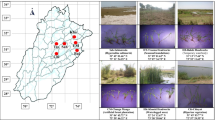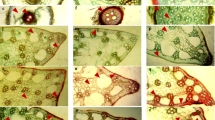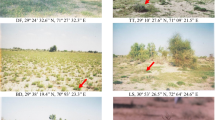Abstract
Genus Fimbristylis colonizes salt-affected wetlands and salt marshes of tropical and subtropical areas of the world. Populations of three Fimbristylis spp. (F. complanata, F. dichotoma and F. rigidula) were collected from differently salt-affected wetlands (HT-Treemu Headworks, least saline; JR-Jhumra Road, moderately saline and SH-Sahianwala, highly saline). These populations were evaluated for degree of salinity tolerance in relation to shoot ionic contents, biochemical, gas exchanges and anatomical traits. The JR population showed significantly higher concentration of chlorophyll a and b, and, an increased net assimilation (A) and transpiration (E) rates. Stomatal conductance (gs) and water use efficiency were the maximum in highly saline SH populations of F. complanata and F. dichotoma. Leaf osmotic and water potentials turnout to be more negative in SH population. The JR population maintained fairly constant leaf osmotic and water potentials. All SH population maintained high turgor potential. The SH population of F. complanata accumulated high total soluble proteins (TSP) as compared to counterpart populations, while in case of F. rigidula TSP was maximum in JR population. The SH population accumulated excess amounts of total soluble sugars and free amino acids for better osmotic adjustments in all species of Fimbristylis. Additionally, more accumulation of Na+, but also promoted K+ and Ca2+ uptake among all species of Fimbristylis. All Fimbristylis populations showed specific anatomical modifications at higher salinity levels. At root level, an increase in the epidermal cell area, cortical region (enhance water storage), thickened exodermal layers, efficient conducting tissues (metaxylem, phloem) were observed. Stem adaptations included increased stem radius and vascular bundle thickness, and large metaxylem vessels. Leaf modifications consisted of broad midrib and lamina. In conclusion, all these species showed greater salinity tolerance and survived up to the highest saline levels. Therefore, this study strongly recommends using these species for revegetation and phytoremediation of the salt-affected lands.








Similar content being viewed by others
Data availability
Authors confirm that all relevant data are included in the article and would be ready to share the raw data upon request.
Code availability
R was used for all analyses. This is a free open source software. https://www.r-project.org/.
References
Afzal A, Duiker SW, Watson JE (2017) Leaf thickness to predict plant water status. Biosyst Eng 156:148–156. https://doi.org/10.1016/j.biosystemseng.2017.01.011
Akcin A, Yalcin E (2016) Effect of salinity stress on chlorophyll, carotenoid content, and proline in Salicornia prostrata Pall. and Suaeda prostrata Pall. subsp. prostrata (Amaranthaceae). Brazil J Bot 39:101–106. https://doi.org/10.1007/s40415-015-0218-y
Akcin TA, Akcin A, Yalcin E (2015) Anatomical adaptations to salinity in Spergularia marina (Caryophyllaceae) from Turkey. Proc Natl Acad Sci India B 85:625–634. https://doi.org/10.1007/s40011-014-0386-8
Akhtar N, Hameed M, Ahmad R (2016) Structural and functional aspects of ionic relation in roots of Typha domingensis pers. ecotypes under salt stress. Pak J Bot 48:2195–2203
Arnon DI (1949) Copper enzymes in isolated chloroplasts polyphenoloxidase in Beta Vulgaris. Plant Physiol 24:1–15. https://doi.org/10.1104/pp.24.1.1
Ashraf M, Harris PJC (2013) Photosynthesis under stressful environments: an overview. Photosynthetica 51:163–190. https://doi.org/10.1007/s11099-013-0021-6
Assaha DVM, Ueda A, Saneoka H, Al-Yahyai R, Yaish MW (2017) The role of Na+ and K+ transporters in salt stress adaptation in glycophytes. Front Physiol 8:509. https://doi.org/10.3389/fphys.2017.00509
Azizian A, Sepaskhah AR, Zand-Parsa S (2015) Modification of a maize simulation model under different water, nitrogen and salinity levels. Int J Plant Prod 9:609–632
Badri MA, Hamed AI (2000) Nutrient value of plants in an extremely arid environment (Wadi Allaqi biosphere reserve, Egypt). J Arid Environ 44:347–356
Banerjee S, Kar D, Banerjee A, Palit D (2012) Utilization of some aquatic macrophytes in Borobandh-a lentic water body in Durgapur, West Bengal, India: Implications for socio-economic upliftment of local stakeholder. Indian J Appl Pure Biol 27:83–92
Batool R, Hameed M (2013) Root structural modifications in three Schoenoplectus (Reichenb.) Palla species for salt tolerance. Pak J Bot 45:1969–1974
Butt MA, Zafar M, Ahmad M, Sultana S, Ullah F, Jan G, Irfan A, Naqvi SAZ (2018) Morpho-palynological study of cyperaceae from wetlands of Azad Jammu and Kashmir using SEM and LM. Microsc Res Tech 81:458–468. https://doi.org/10.1002/jemt.22999
Byrt CS, Munns R, Burton RA, Gilliham M, Wege S (2018) Root cell wall solutions for crop plants in saline soils. Plant Sci 269:47–55. https://doi.org/10.1016/j.plantsci.2017.12.012
Cannella D, Möllers KB, Frigaard NU, Jensen PE, Bjerrum MJ, Johanse KS, Felby C (2016) Light-driven oxidation of polysaccharides by photosynthetic pigments and a metalloenzyme. Nat Commun 7:1–8. https://doi.org/10.1038/ncomms11134
Cheng B, Li Z, Liang L, Cao Y, Zeng W, Zhang X, Ma X, Huang L, Nie G, Liu W, Peng Y (2018) The γ-aminobutyric acid (GABA) alleviates salt stress damage during seeds germination of white clover associated with Na+/K+ transportation, dehydrins accumulation, and stress-related genes expression in white clover. Int J Mol Sci 19:2520
Cheng R, Zhu H, Cheng X, Shutes B, Yan B (2020) Saline and Alkaline tolerance of wetland plants—what are the most representative evaluation indicators? Sustainability 12:1913
Corrêa FF, Pereira MP, Madail RH, Santos BR, Barbosa S, Castro EM, Pereira FJ (2017) Anatomical traits related to stress in high density populations of Typha angustifolia L. (Typhaceae). Braz J Biol 77:52–59. https://doi.org/10.1590/1519-6984.09715
Davis BH (1976) Carotenoids. In: Goodwin TW (ed) Chemistry and biochemistry of plant pigments, 2nd edn. Academic Press Inc, London, pp 38–165
Dolatabadian A, Sanavy SAMM, Ghanati F (2011) Effect of salinity on growth, xylem structure and anatomical characteristics of soybean. Not Sci Biol 3:41–45. https://doi.org/10.15835/nsb315627
dos Santos MR, Soares TL, Lima LKS, Gheyi HR, Jesus ON, Coelho Filho MA (2019) Salinity-induced changes in biometric, physiological and anatomical parameters of Passiflora edulis Sims plants propagated by different methods. Arch Agron Soil Sci 5:1–5. https://doi.org/10.1080/03650340.2019.1688789
Dubois M, Gilles KA, Hamilton JK, Rebers PA, Smith F (1951) A colorimetric method for the determination of sugars. Nature 168:167. https://doi.org/10.1038/168167a0
Escalante-Magana C, Aguilar-Caamal LF, Echevarría-Machado I, Medina-Lara F, Cach LS, Martínez-Estévez M (2019) Contribution of glycine betaine and proline to water deficit tolerance in pepper plants. HortScience 54:1044–1054. https://doi.org/10.21273/HORTSCI13955-19
Ferchichi S, Hessini K, Dell’Aversana E, D’Amelia L, Woodrow P, Ciarmiello LF, Fuggi A, Carillo P (2018) Hordeum vulgare and Hordeum maritimum respond to extended salinity stress displaying different temporal accumulation pattern of metabolites. Funct Plant Biol 45:1096–1109. https://doi.org/10.1071/FP18046
Flowers TJ, Munns R, Colmer TD (2015) Sodium chloride toxicity and the cellular basis of salt tolerance in halophytes. Ann Bot 115:419–431. https://doi.org/10.1093/aob/mcu217
Hameed M, Ashraf M, Naz N (2011) Anatomical and physiological characteristics relating to ionic relations in some salt tolerant grasses from the salt range. Pakistan Acta Physiol Plant 33:1399–1409. https://doi.org/10.1007/s11738-010-0674-8
Jacobsen AL, Ewers FW, Pratt RB, Paddock WA, Davis SD (2005) Do xylem fibers affect vessel cavitation resistance? Plant Physiol 139:546–556
Jiang C, Zu C, Lu D, Zheng Q, Shen J, Wang H, Li D (2017) Effect of exogenous selenium supply on photosynthesis, Na+ accumulation and antioxidative capacity of maize (Zea mays L.) under salinity stress. Sci Rep 7:42039. https://doi.org/10.1038/srep42039
Kaburagi E, Morikawa Y, Yamada M, Fujiyama H (2014) Sodium enhances nitrate uptake in Swiss chard (Beta vulgaris var. cicla L.). Soil Sci Plant Nutr 60:651–658
Kaleem M, Hameed M (2021) Functional traits for salinity tolerance in differently adapted populations of Fimbristylis complanata (Retz.). Int J Phytoremed. https://doi.org/10.1080/15226514.2021.1895718
Kausar A, Ashraf MY, Ali I, Niaz M, Abbass Q (2012) Evaluation of sorghum varieties/lines for salt tolerance using physiological indices as screening tool. Pak J Bot 44:47–52
Khan MA, Qaiser M (2006) Halophytes of Pakistan: characteristics, distribution and potential economic usages. Sabkha Ecosystems. Springer, Dordrecht, pp 129–153. https://doi.org/10.1007/978-1-4020-5072-5_11
Kumar A, Kumar A, Lata C, Kumar S (2016) Eco-physiological responses of Aeluropus lagopoides (grass halophyte) and Suaeda nudiflora (non-grass halophyte) under individual and interactive sodic and salt stress. S Afr J Bot 105:36–44
Kumari R, Kumar P, Meghawal D, Sharma V, Kumar H (2019) Salt-tolerance mechanisms in plants. Recent trends in tropical plant research. AkiNik Publications, New Delhi
Lemoine R, La Camera S, Atanassova R, Dédaldéchamp F, Allario T, Pourtau N, Bonnemain JL, Laloi M, Coutos-Thévenot P, Maurousset L (2013) Source-to-sink transport of sugar and regulation by environmental factors. Front Plant Sci 4:272. https://doi.org/10.3389/fpls.2013.00272
Liu Y, Li X, Chen G, Li M, Liu M, Liu D (2015) Epidermal micromorphology and mesophyll structure of Populus euphratica heteromorphic leaves at different development stages. PLoS ONE 10:e0137701. https://doi.org/10.1371/journal.pone.0137701
Lowry OH, Rosebrough NJ, Farr AL, Randall RJ (1951) Protein measurement with the folin phenol reagent. J Biol Chem 193:265–275
Mansoor U, Fatima S, Hameed M, Naseer M, Ahmad MSA, Ashraf M, Ahmad F, Waseem M (2019) Structural modifications for drought tolerance in stem and leaves of Cenchrus ciliaris L. ecotypes from the Cholistan Desert. Flora 261:151485. https://doi.org/10.1016/j.flora.2019.151485
Mohammed AS, Kapri A, Goel R (2011) Heavy metal pollution: source, impact, and remedies. Biomanagement of metal-contaminated soils. Springer, Dordrecht, pp 1–28
Moore S, Stein WH (1948) Photometric nin-hydrin method for use in the ehromatography of amino acids. J Biol Chem 176:367–388
Muchate NS, Nikalje GC, Rajurkar NS, Suprasanna P, Nikam TD (2016) Plant salt stress: adaptive responses, tolerance mechanism and bioengineering for salt tolerance. Bot Rev 82:371–406. https://doi.org/10.1007/s12229-016-9173-y
Naseer M, Hameed M, Zahoor A, Ahmad F, Fatima S, Ahmad MSA, Ahmad KS, Iftikhar M (2017) Photosynthetic response in buttonwood (Conocarpus erectus L.) to salt stress. Pak J Bot 49:847–856
Naskar S, Palit PK (2015) Anatomical and physiological adaptations of mangroves. Wetl Ecol Manag 23:357–370. https://doi.org/10.1007/s11273-014-9385-z
Naz N, Batool R, Fatima S, Hameed M, Ashraf M, Ahmad F, Ahmad MSA (2015) Adaptive components of tolerance to salinity in a saline desert grass Lasiurus scindicus Henrard. Ecol Res 30:429–438. https://doi.org/10.1007/s11284-014-1236-0
Naz N, Fatima S, Hameed M, Naseer M, Batool R, Ashraf M, Ahmad F, Ahmad MSA, Zahoor A, Ahmad KS (2016) Adaptations for salinity tolerance in Sporobolus ioclados (Nees ex Trin.) Nees from saline desert. Flora 223:46–55. https://doi.org/10.1016/j.flora.2016.04.013
Negrão S, Schmöckel SM, Tester M (2017) Evaluating physiological responses of plants to salinity stress. Ann Bot 119:1–11. https://doi.org/10.1093/aob/mcw191
Nieves-Cordones M, Al Shiblawi FR, Sentenac H (2016) Roles and transport of sodium and potassium in plants. The alkali metal ions: their role for life. Springer, Cham, pp 291–324. https://doi.org/10.1007/978-3-319-21756-7_9
Osakabe Y, Osakabe K, Shinozaki K, Tran L-SP (2014) Response of plants to water stress. Front Plant Sci 5:86. https://doi.org/10.3389/fpls.2014.00086
Paradiso R, Arena C, De Micco V, Giordano M, Aronne G, De Pascale S (2017) Changes in leaf anatomical traits enhanced photosynthetic activity of soybean grown in hydroponics with plant growth-promoting microorganisms. Front Plant Sci 8:674. https://doi.org/10.3389/fpls.2017.00674
Percey WJ, Shabala L, Wu Q, Su N, Breadmore MC, Guijt RM, Bose J, Shabala S (2016) Potassium retention in leaf mesophyll as an element of salinity tissue tolerance in halophytes. Plant Physiol Biochem 109:346–354. https://doi.org/10.1016/j.plaphy.2016.10.011
R Core Team (2019) R foundation for statistical computing. R: a language and environment for statistical computing. R Core Team, Vienna
Radhakrishnan R, Baek KH (2017) Physiological and biochemical perspectives of non-salt tolerant plants during bacterial interaction against soil salinity. Plant Physiol Biochem 116:116–126. https://doi.org/10.1016/j.plaphy.2017.05.009
Rahat QUA, Hameed M, Ahmad MSA (2019) Contribution of root structural and functional features towards salinity tolerance in Diplachne fusca (L.) P. Beauv. ex Roem. & Schult. subsp. fusca. Pak J Bot 51:773–779
Rahman A, Nahar K, Hasanuzzaman M, Fujita M (2016) Calcium supplementation improves Na+/K+ ratio, antioxidant defense and glyoxalase systems in salt-stressed rice seedlings. Front Plant Sci 7:609. https://doi.org/10.3389/fpls.2016.00609
Rangani J, Parida AK, Panda A, Kumari A (2016) Coordinated changes in antioxidative enzymes protect the photosynthetic machinery from salinity induced oxidative damage and confer salt tolerance in an extreme halophyte Salvadora persica L. Front Plant Sci 7:50. https://doi.org/10.3389/fpls.2016.00050
Reddy PS, Jogeswar G, Rasineni GK, Maheswari M, Reddy AR, Varshney RK, Kishor PBK (2015) Proline over-accumulation alleviates salt stress and protects photosynthetic and antioxidant enzyme activities in transgenic sorghum [Sorghum bicolor (L.) Moench]. Plant Physiol Biochem 94:104–113. https://doi.org/10.1016/j.plaphy.2015.05.014
Roy SJ, Negrão S, Tester M (2014) Salt resistant crop plants. Curr Opin Biotechnol 26:115–124. https://doi.org/10.1016/j.copbio.2013.12.004
Roy R, Daula ASU, Akter A, Sultana S, Barek MA, Liya IJ, Basher MA (2019) Antipyretic and anti-nociceptive effects of methanol extract of leaves of Fimbristylis miliacea in mice model. J Ethnopharmacol 243:112080. https://doi.org/10.1016/j.jep.2019.112080
Rozentsvet O, Nesterov V, Bogdanova E, Kosobryukhov A, Subova S, Semenova G (2018) Structural and molecular strategy of photosynthetic apparatus organisation of wild flora halophytes. Plant Physiol Biochem 129:213–220. https://doi.org/10.1016/j.plaphy.2018.06.006
Ruzin SE (1999) Plant microtechnique and microscopy, vol 198. Oxford University Press, New York
Sghaier DB, Duarte B, Bankaji I, Caçador I, Sleimi N (2015) Growth, chlorophyll fluorescence and mineral nutrition in the halophyte Tamarix gallica cultivated in combined stress conditions: arsenic and NaCl. J Photochem Photobio B Biol 149:204–214. https://doi.org/10.1016/j.jphotobiol.2015.06.003
Shabala S (2017) Signalling by potassium: another second messenger to add to the list? J Exp Bot 68:4003–4007
Shabala S, Pottosin I (2014) Regulation of potassium transport in plants under hostile conditions: implications for abiotic and biotic stress tolerance. Physiol Plant 151:257–279
Shrivastava P, Kumar R (2015) Soil salinity: a serious environmental issue and plant growth promoting bacteria as one of the tools for its alleviation. Saudi J Biol Sci 22:123–131. https://doi.org/10.1016/j.sjbs.2014.12.001
Sims JR, Haby VA (1971) Simplified colorimetric determination of soil organic matter. Soil Sci 112:137–141. https://doi.org/10.1097/00010694-197108000-00007
Singh M, Kumar J, Singh S, Singh VP, Prasad SM (2015) Roles of osmoprotectants in improving salinity and drought tolerance in plants: a review. Rev Environ Sci Biotechnol 14:407–426
Slama I, Abdelly C, Bouchereau A, Flowers T, Savoure A (2015) Diversity, distribution and roles of osmoprotective compounds accumulated in halophytes under abiotic stress. Ann Bot 115:433–447. https://doi.org/10.1093/aob/mcu239
Smith MS, Fridley JD, Yin J, Bauerle TL (2013) Contrasting xylem vessel constraints on hydraulic conductivity between native and non-native woody understory species. Front Plant Sci 4:486. https://doi.org/10.3389/fpls.2013.00486
Stefanov M, Yotsova E, Rashkov G, Ivanova K, Markovska Y, Apostolova EL (2016) Effects of salinity on the photosynthetic apparatus of two Paulownia lines. Plant Physiol Biochem 101:54–59. https://doi.org/10.1016/j.plaphy.2016.01.017
Stefanov M, Yotsova E, Markovska Y, Apostolova EL (2018) Effect of high light intensity on the photosynthetic apparatus of two hybrid lines of Paulownia grown on soils with different salinity. Photosynthetica 56:832–840. https://doi.org/10.1007/s11099-017-0735-y
Tahira N, Mansoor H, Ahmad MSA, Adnan Y, Hina K (2012) Comparative anatomy of root and stem of some native and exotic Asparagus L. species. Pak J Bot 44:153–158
U.S. Salinity Laboratory Staff (1954) Diagnosis and improvement of saline and alkali soils. USDA agricultural handbook No 60. USDA, Washington DC, p 160
Vaiga M, Joseph S (2016) Identification of mangrove and mangrove associates in Kannur district of Kerala including their economic–ecological linkages. Int J Bot Stud 1:22–31
Vaziriyeganeh M, Lee SH, Zwiazek JJ (2018) Water transport properties of root cells contribute to salt tolerance in halophytic grasses Poa juncifolia and Puccinellia nuttalliana. Plant Sci 276:54–62
Wang X, Cheng R, Zhu H, Cheng X, Shutes B, Yan B (2020) Seed germination and early seedling growth of six wetland plant species in saline-alkaline environment. Int J Phytoremed 22:1185–1194
Wolf B (1982) An improved universal extracting solution and its use for diagnosing soil fertility. Commun Soil Sci Plant Anal 13:1005–1033. https://doi.org/10.1080/00103628209367331
Yamamoto K, Hashimoto Y, Kang J, Kobayashi K (2018) Speciation of phosphorus zinc and copper in soil and water-dispersible colloid affected by a long-term application of swine manure compost. Environ Sci Technol 52:13270–13278
Yoshida S, Forno DA, Cock JH (1971) Laboratory manual for physiological studies of rice. IRRI, Los Banos
Zahoor I, Ahmad MSA, Hameed M, Nawaz T, Tarteel A (2012) Comparative salinity tolerance of Fimbristylis dichotoma (L.) Vahl and Schoenoplectus juncoides (Roxb.) Palla, the candidate sedges for rehabilitation of saline wetlands. Pak J Bot 44:1–6
Zhang S, Songyun L, Koyama T and Simpson DA (2010) Fimbristylis Vahl, In: Cyperaceae. Flora of China. 23, 200–218
Zhang Z, He K, Zhang T, Tang D, Li R, Jia S (2019) Physiological responses of Goji berry (Lycium barbarum L.) to saline-alkaline soil from Qinghai region. China Sci Rep 9:1–11. https://doi.org/10.1038/s41598-019-48514-5
Zörb C, Geilfus CM, Dietz KJ (2019) Salinity and crop yield. Plant Biol 21:31–38. https://doi.org/10.1111/plb.12884
Funding
The project is not funded by any organization.
Author information
Authors and Affiliations
Contributions
This work is part of a Ph.D. dissertation of MK under the supervision of MH.
Corresponding author
Ethics declarations
Conflict of interest
Authors declared that they have no conflict of interest/competing interest.
Ethical approval
The matter given in this manuscript is in compliance with ethical standards. The research work given in this paper does not involve human participants or animals.
Consent to participate
The consent to participate in this study was obtained by the authors from the authorities concerned.
Consent to publish
We consent to have this research published in this journal.
Research involving animal participants
Animals are not involved in this study.
Additional information
Publisher's Note
Springer Nature remains neutral with regard to jurisdictional claims in published maps and institutional affiliations.
Rights and permissions
About this article
Cite this article
Kaleem, M., Hameed, M. Structural and functional modifications in Fimbristylis Vahl for ecological fitness in hyper-saline wetlands. Wetlands Ecol Manage 29, 843–865 (2021). https://doi.org/10.1007/s11273-021-09814-8
Received:
Accepted:
Published:
Issue Date:
DOI: https://doi.org/10.1007/s11273-021-09814-8




